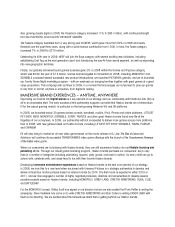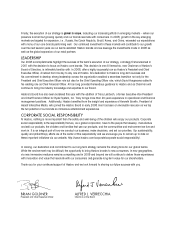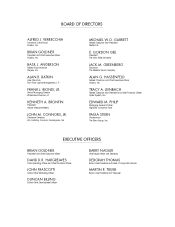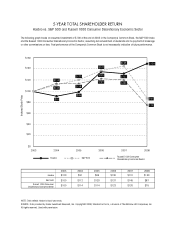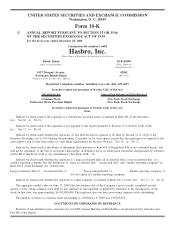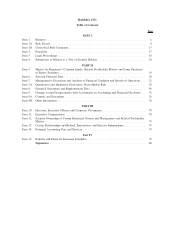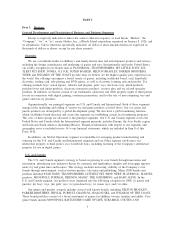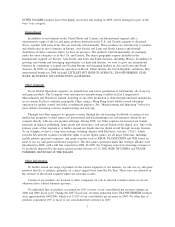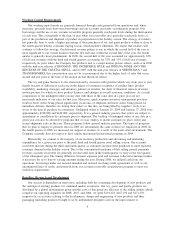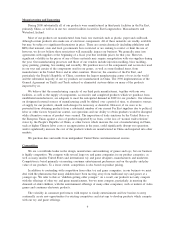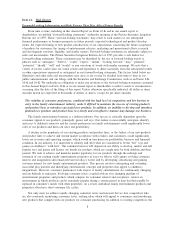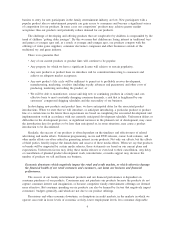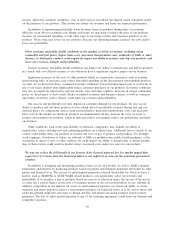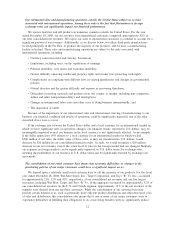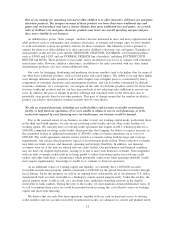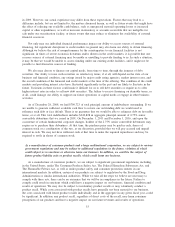Hasbro 2008 Annual Report Download - page 15
Download and view the complete annual report
Please find page 15 of the 2008 Hasbro annual report below. You can navigate through the pages in the report by either clicking on the pages listed below, or by using the keyword search tool below to find specific information within the annual report.
modification of ongoing products. Much of this work is performed by our internal staff of designers, artists,
model makers and engineers.
In addition to the design and development work performed by our own staff, we deal with a number of
independent toy and game designers for whose designs and ideas we compete with other toy and game
manufacturers. Rights to such designs and ideas, when acquired by us, are usually exclusive and the
agreements require us to pay the designer a royalty on our net sales of the item. These designer royalty
agreements, in some cases, also provide for advance royalties and minimum guarantees.
We also produce a number of toys and games under trademarks and copyrights utilizing the names or
likenesses of characters from movies, television shows and other entertainment media, for whose rights we
compete with other toy and game manufacturers. Licensing fees for these rights are generally paid as a royalty
on our net sales of the item. Licenses for the use of characters are generally exclusive for specific products or
product lines in specified territories. In many instances, advance royalties and minimum guarantees are
required by these license agreements. In 2008, 2007, and 2006, we incurred $312,986, $316,807 and $169,731,
respectively, of royalty expense. A portion of this expense relates to amounts paid in prior years as royalty
advances. Our royalty expenses in any given year vary depending upon the timing of movie releases and other
entertainment. Royalty expense in 2008 and 2007 was more significant in those years as compared to 2006
due to the release of IRONMAN, THE INCREDIBLE HULK and INDIANA JONES AND THE KINGDOM
OF THE CRYSTAL SKULL in 2008 and SPIDER-MAN 3 and TRANSFORMERS in 2007. In addition,
royalty expense related to sales of STAR WARS products were significant in both of these years.
Marketing and Sales
As we are focused on reimagining, reinventing and reigniting our many brands on a consistent global
basis, we have a global marketing function which establishes brand direction and messaging, as well as assists
the selling entities in establishing certain local marketing programs. The costs of this group are allocated to
the selling entities. Our products are sold nationally and internationally to a broad spectrum of customers,
including wholesalers, distributors, chain stores, discount stores, mail order houses, catalog stores, department
stores and other traditional retailers, large and small, as well as internet-based “e-tailers.” Our own sales forces
account for the majority of sales of our products. Remaining sales are generated by independent distributors
who sell our products, for the most part, in areas of the world where we do not otherwise maintain a direct
presence. While we have thousands of customers, including over 1,800 in the United States during 2008, there
has been significant consolidation at the retail level over the last several years in our industry. As a result, the
majority of our sales are to large chain stores, distributors and wholesalers. While the consolidation of
customers provides us with certain benefits, such as potentially more efficient product distribution and other
decreased costs of sales and distribution, this consolidation also creates additional risks to our business
associated with a major customer having financial difficulties or reducing its business with us. In addition,
customer concentration may decrease the prices we are able to obtain for some of our products and reduce the
number of products we would otherwise be able to bring to market. During 2008, net revenues from our three
largest customers, Wal-Mart Stores, Inc., Target Corporation and Toys “R” Us, Inc., represented 25%, 12%
and 10%, respectively, of consolidated net revenues, and sales to our top five customers, including Wal-Mart,
Target and Toys “R” Us, Inc., accounted for approximately 52% of our consolidated net revenues. In the
U.S. and Canada segment, approximately 71% of the net revenues of the segment were derived from our top
three customers.
We advertise many of our toy and game products extensively on television. Generally our advertising
highlights selected items in our various product groups in a manner designed to promote the sale of not only
the selected item, but also other items we offer in those product groups as well. We introduce many of our
new products to major customers during the year prior to the year of introduction of such products for retail
sale. In addition, we showcase certain of our new products in New York City at the time of the American
International Toy Fair in February, as well as at other international toy shows.
In 2008 we spent $454,612 on advertising, promotion and marketing programs compared to $434,742 in
2007 and $368,996 in 2006.
5


